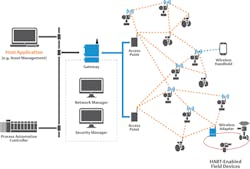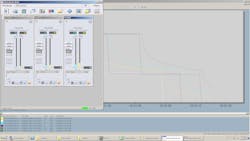Real-time control with WirelessHART communication
Many automation professionals are using wireless instrumentation networks such as WirelessHART for monitoring applications, but few have employed the technology for real-time control. This paradigm is changing due to improved wireless gateway communications, along with specific wireless control algorithms, empowering end users to realize the benefits of wireless control.
Why wireless?
Increasing numbers of companies are taking advantage of wireless instrumentation networks for process monitoring due to the following benefits compared to wired infrastructure:
- Low cost installation
- Ability to obtain process measurements from moving equipment, such as rotary drum dryers, mobile carts, etc.)
- Ability to “try” process measurements in a variety of areas to obtain the optimum location
- Low cost of adding a wireless measurement allows a company to add process data measurements that could not be economically justified with wired installations
All of the information provided by wireless measurements can now be brought into the automation system for monitoring, alarming, historization and improved operations — as well as for real-time control in certain applications.
While the number of wireless monitoring applications has grown dramatically, far fewer people have utilized wireless for real-time control. When asked, most automation professionals will cite concerns of unreliable communications, slow and variable update times, and a reticence to be on the bleeding edge of technology. However, that thinking is changing as those and other concerns are addressed.
WirelessHART provides self-organizing, adaptive mesh communication and offers high-speed, reliable, secure and redundant wireless communications. Specific control algorithms such as PIDPlus have been developed to handle the variable update rates inherent with wireless communications. Major companies are starting to build distillation units, and even entire plants, using all wireless instrumentation. These facilities take full advantage of the previously mentioned benefits of wireless.
The following example highlights how one company used wireless to improve operations.
A moving dilemma
A large chemical company based in North America recently employed WirelessHART control in its product development lab area. The lab was comprised of a large number of small batch reactors processing a variety of different new products. Since the raw materials varied significantly from reactor to reactor and from day to day, the lab utilized a collection of mobile raw material carts to charge materials into the reactors.
Each cart consisted of three Coriolis flowmeters, three control valves with digital valve positioners, and three local flow controllers. The charges were set up by the operators, who manually entered the charge amounts and continuously monitored the flows to ensure the flow rate and total charge values were correct. There were several significant limitations to this arrangement:
Each cart had to be continuously monitored by an operator in the area. This limited the number of simultaneous reactor charges.
There was no means to historize the data or analyze it after the fact, which was particularly important when batches did not turn out as expected.
The batch automation system was blind to the raw material flow charges and had no means other than manual tasks to monitor and/or control these flows. It also could not save the data into the electronic batch record.
Using Emerson’s Operational Certainty process (see Figure 2), the plant analyzed their current situation and realized there was potential for significant improvement if they could bring the data from the mobile cart instrumentation into their automation system.This new arrangement would improve flow control, allow the operator to consistently monitor simultaneous charges from a single remote location, provide a means to historize the data, and allow the batch system to control the entire process and save the associated data. The project would yield even greater savings if it did not require replacement of the existing hardwired instrumentation and control valve positioners.
Wireless control is the solution
After evaluating their options, the facility decided to pursue a wireless control strategy. Rather than replacing the instruments, which would have been expensive and time-consuming, they installed THUM wireless modules on each transmitter (as shown in Figure 1) and a digital valve positioner (as shown in Figure 3).
A THUM module allows a wired transmitter to communicate over a WirelessHART network by transmitting the 4-20 mA process variable signal to the automation system, and it allows a valve positioner to be controlled by the automation system via WirelessHART.The THUM also provides a fully functional HART communication interface, allowing device diagnostics to be monitored and the device to be configured, all via the WirelessHART gateway. The gateway is connected to the automation system by a hardwired communications link via Modbus TCP.
Since the cart required 120 VAC power for Coriolis meters, the same power source was used to feed a 24 VDC power supply that powered all six instrument loops.
To facilitate communications with the cart instrumentation, the plant installed a redundant WirelessHART gateway and tied it into their automation system network (see Figure 4).The wireless communications use a self-organizing network based on an adaptive mesh arrangement that can automatically self-heal if communication with an instrument is interrupted. The security of the data transfer is protected by encryption, authentication, verification, anti-jamming and network key management.
Once the data links were established between the field instrumentation and the automation system, the rest of the project was quite straightforward. The flow control loops were programmed into the system using PIDPlus control blocks (see Figure 5). The PIDPlus algorithm was specifically developed to allow the controller to continue to operate consistently and reliably despite variable update times of up to 30 seconds. Once those modules were created, the flow loops were added to the automation system graphics and the material charges were incorporated into the batch program.The results
The improvements were dramatic and immediate and have proven to be valuable over both the short and long term.
The flow control data for all of the reactor flow loops is now available on any operator station, and charge flows for numerous reactors can be continuously monitored and alarmed. In addition, all the flow data can now be trended and stored in the historian for future reference.
The charges can be programmed into the batch system, with the resulting charge values written to the batch record upon completion of the charge. What’s more, none of the existing Coriolis meters, control valves and digital positioners required replacement — resulting in significant savings.
Wireless control issues to consider
While this is just one example of a wireless control application, there are countless others that can offer significant value. However, there are some technical limitations to wireless control, including:
- The fastest update time for a THUM module is eight seconds, so THUM modules are not well-suited for very high-speed flow and pressure control loops or for any loop that must be updated in less than eight seconds.
- Native wireless instruments can update at faster rates, but if the instrument is battery powered, the battery life will be significantly shortened.
- The variable update times inherent in wireless tend to create unstable control with a standard PID control algorithm when control periods are less than one minute. So a modified PID algorithm should be used, such as PIDPlus, which takes these infrequent update times into consideration as the control response is calculated.
- Wireless downstream communications to output devices are not currently scheduled and can be significantly delayed. However, the next generation of HART gateway wireless software will include scheduled downstream communications.
- If battery-powered devices are used, the battery status should be monitored, and the batteries should be periodically replaced to avoid unexpected loss of data.
- Wireless output devices should be configured to fail safely should they lose communication with the automation system for an extended length of time.
Despite these limitations, wireless control is viable for many process automation applications — as most do not require fast update rates.
Conclusion
Recent improvements in wireless gateways, wireless mesh networks and control algorithms have taken WirelessHART control from the world of research studies and theory into operating plants. While there are technical considerations that must be evaluated, the savings and value offered by wireless control make the technology worth considering for many process automation applications.Kurtis Jensen is a global manager for Emerson. He is responsible for product development, serving as an advocate and promoter of innovative technologies that benefit end users. Jensen has over 35 years’ experience in field service, control systems, SCADA, RTUs, communications, cybersecurity wireless technologies and field instrumentation.
Sean Heine is an account manager for Novaspect. He is responsible for Emerson’s Final Control portfolio. Heine has been working in various capacities at Novaspect for the last five years, including six months at Emerson’s Fisher facility in Marshalltown, Iowa.
About the Author
Kurtis Jensen
Portfolio manager for Emerson
Kurtis Jensen is a portfolio manager for Emerson responsible for product development, serving as an advocate and promoter of innovative technologies that benefit end users. He has over 40 years of experience in field service, system integration, asset management, cybersecurity wireless technologies and field instrumentation. He holds a BA degree in Business Administration and Management from Buena Vista University, and an MBA degree from the University of Dubuque.






